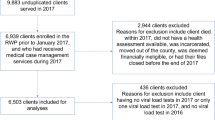Abstract
Achieving viral suppression among HIV-positive persons is a critical component of HIV treatment and prevention, because it leads to improved health outcomes for the individual and reduced risk of HIV transmission. There is wide variation in viral suppression across jurisdictions, races/ethnicities, age groups, and transmission risk groups. This analysis uses HIV surveillance data to examine rates of viral suppression among people living with diagnosed HIV (PLWDH) in 38 jurisdictions with complete lab reporting. Among people who received a diagnosis in 2014, the percentage with viral suppression within 12 months of diagnosis and the average time to viral suppression was assessed. Overall, among PLWDH in 2014, 57.9% were virally suppressed, and, among people with HIV diagnosed in 2014, 68.2% were suppressed within 12 months of diagnosis with an average time to suppression of 6.9 months. All outcomes varied by jurisdiction, but most had similar patterns of disparities with a few exceptions. These data highlight the need for tailored interventions at the local level. In addition, jurisdictions with relatively low viral suppression among particular groups could adapt effective interventions from jurisdictions who have higher rates of suppression.



Similar content being viewed by others
References
Cohen, M. S., Chen, Y. Q., McCauley, M., et al. (2011). Prevention of HIV-1 infection with early antiretroviral therapy. The New England Journal of Medicine, 365(6), 493–505.
Lingappa, J. R., Hughes, J. P., Wang, R. S., et al. (2010). Estimating the impact of plasma HIV-1 RNA reductions on heterosexual HIV-1 transmission risk. PLoS ONE, 5(9), e12598.
National HIV/AIDS strategy for the United States: Updated to 2020 July 2015 [May 19, 2017]. Available from: https://www.hiv.gov/sites/default/files/nhas-update.pdf.
CDC. Monitoring selected national HIV prevention and care objectives by using HIV surveillance data—United States and 6 dependent areas, 2015. HIV Surveillance Supplemental Report [Internet], 2017, 22(2). Available from: http://www.cdc.gov/hiv/library/reports/surveillance.
Harrison, K. M., Kajese, T., Hall, H. I., & Song, R. (2008). Risk factor redistribution of the national HIV/AIDS surveillance data: An alternative approach. Public Health Reports (Washington, D. C.: 1974), 123(5), 618–627.
CDC. Monitoring selected national HIV prevention and care objectives by using HIV surveillance data - United States and 6 dependent areas, 2014. HIV Surveillance Supplemental Report [Internet], [May 19, 2016], 2017; 21(4). Available from: http://www.cdc.gov/hiv/library/reports/surveillance.
CDC. Anti-retroviral treatment and access to servies (ARTAS) [June 8, 2017]. Available from: https://effectiveinterventions.cdc.gov/en/HighImpactPrevention/PublicHealthStrategies/ARTAS.aspx.
CDC. Every dose every day [June 8, 2017]. Available from: https://effectiveinterventions.cdc.gov/en/HighImpactPrevention/BiomedicalInterventions/MedicationAdherence.aspx.
CDC. Data to Care: Improving health and prevention [June 8, 2017]. Available from: https://effectiveinterventions.cdc.gov/en/HighImpactPrevention/PublicHealthStrategies/DatatoCare.aspx.
Department of Health and Human Services. Guidelines for the use of antiretroviral agents in HIV-1-infected adults and adolescents. [June 9, 2017]. Available from: http://www.aidsinfo.nih.gov/ContentFiles/AdultandAdolescentGL.pdf.
Colasanti, J., Stahl, N., Farber, E. W., Del Rio, C., & Armstrong, W. S. (2017). An exploratory study to assess individual and structural level barriers associated with poor retention and re-engagement in care among persons living with HIV/AIDS. Journal of Acquired Immune Deficiency Syndromes (1999), 74(Suppl 2), S113–S120.
Aberg, J. A., Gallant, J. E., Ghanem, K. G., et al. (2014). Primary care guidelines for the management of persons infected with HIV: 2013 update by the HIV Medicine Association of the Infectious Diseases Society of America. Clinical Infectious Diseases: An Official Publication of the Infectious Diseases Society of America, 58(1), 1–10.
Funding
All work was supported by the Centers for Disease Control and Prevention.
Disclaimer
The findings and conclusions in this report are those of the authors and do not necessarily represent the official position of the Centers for Disease Control and Prevention.
Author information
Authors and Affiliations
Corresponding author
Ethics declarations
Conflict of interest
The authors declare that they have no conflict of interest.
Rights and permissions
About this article
Cite this article
Hess, K.L., Hall, H.I. HIV Viral Suppression, 37 States and the District of Columbia, 2014. J Community Health 43, 338–347 (2018). https://doi.org/10.1007/s10900-017-0427-3
Published:
Issue Date:
DOI: https://doi.org/10.1007/s10900-017-0427-3



